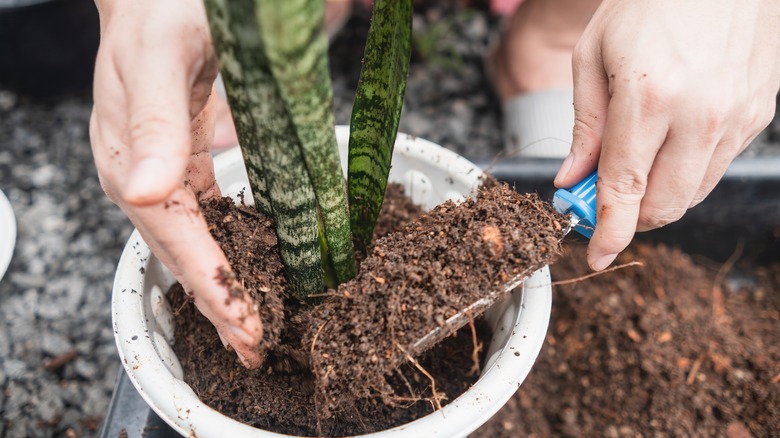Repotting plants, particularly snake plants, can be laborious due to their unique characteristics and susceptibility to harm. Snake plants, known for their tall and elegant fronds, have a sensitive root system that dislikes disturbances. Moreover, their long leaves can become top-heavy and topple over when not secured in place by the soil in the pot, potentially hurting the fronds or roots during the repotting process. Rather than trying to hold all the leaves in place, tie a ribbon or soft rope around the fronds to keep them together while transferring the plant to its new container. This life-changing TikTok hack can help you avoid unfortunate mishaps.
A soft ribbon or rope protects the fronds by providing external support, reducing the risk of breakage or bending, and ensuring the snake plant retains its structural and aesthetic integrity. Once its leaves have been damaged, you can’t do much aside from trimming them to encourage new growth. Thankfully, utilizing the ribbon hack should help you sidestep such issues. If you want to refresh your overgrown snake plant, head to your gift-wrapping drawer and choose your silkiest ribbon to get started.
How to use a ribbon to repot your snake plant
a salute to the snake plant that was sacrificed for the intro of the video 🫡 it ain’t dead, it just didn’t get a ribbon so it looks a lil bit messy 😂🪴 #houseplants #plantsoftiktok #snakeplant #sansevieria #repot
♬ original sound – A PLANT PROJECT
Watch on TikTok
Before removing your snake plant from its current container, prepare a pot at least two inches larger with fresh, well-draining soil. Next, secure the tall fronds to maintain their upright position during the transfer. Encircle the leaves with a soft ribbon or rope that will be gentle on the foliage, tying it snugly but not too tightly to provide support.
Gently lift the snake plant from its original pot and assess the root system, trimming any damaged or rotting roots and loosening them to encourage growth. Position the snake plant in the center of the new container, adjusting the height with additional soil if necessary. Then, carefully lower the plant into the soil, ensuring it stands upright.
After completing the repotting process, remove the ribbon from around the fronds. You should then water the plant sparingly and place it in bright, indirect light to allow it to acclimate to its new environment. This approach safeguards the snake plant’s visual appeal and promotes a smooth transition to its new home.
When to repot your snake plant

If your snake plant’s roots outgrow its current container, take this as a sign that it requires repotting. If you observe roots circling the pot’s surface or emerging from the drainage holes, you have a root-bound houseplant in need of revival. Neglecting to repot in this scenario can lead to a constricted root system, hindering nutrient absorption and water intake. This restriction may result in stunted growth and a decline in the plant’s overall health. Without intervention, it will not flourish and become more susceptible to stress, pests, and diseases.
Overcrowded and congested foliage also indicates that you should repot your snake plant. As it expands, new shoots and fronds may struggle for space, resulting in a crowded and untidy appearance. This overcrowding can hinder the plant’s photosynthesis, affecting its overall vitality. Without providing additional space and resources through repotting, the snake plant’s attractiveness may diminish along with its growth potential.
Finally, if you notice that your snake plant rapidly drains after watering, it may be time to repot. Quick drainage signals compacted or depleted soil, which can lead to symptoms like root dehydration, nutrient deficiency, and impaired water retention over the long term. Your plant’s health could continue to deteriorate, resulting in yellowing leaves, reduced growth, and heightened vulnerability to stress. Repotting allows you to refresh the soil structure, enhancing water retention and nutrient availability for your precious plant.